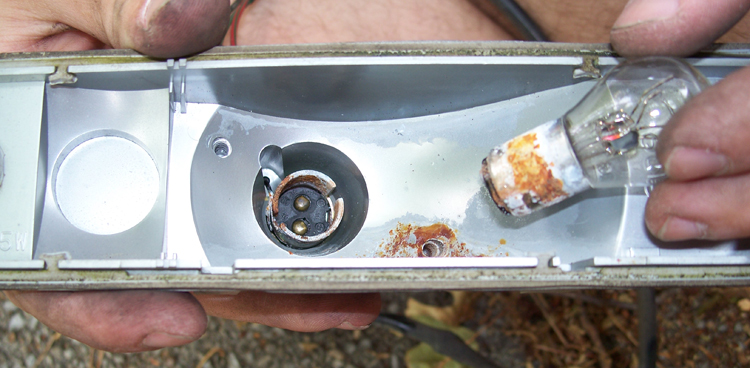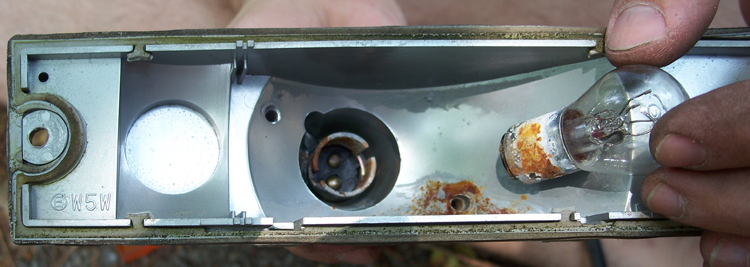This is why headlight switches die
#1
Thread Starter
Joined: May 2006
Posts: 4,219
Likes: 3
From: Murfreesboro, TN
This is why headlight switches die
To clarify real quick this isn't the ONLY reason, but the most common.
Here's a shot of my passenger side front running light.

And here's one with the bulb more in focus.

search words: headlight switch corrosion blown melted fried resistance
Here's a shot of my passenger side front running light.

And here's one with the bulb more in focus.

search words: headlight switch corrosion blown melted fried resistance
#2
That looks very familiar. I cleaned mine when I noticed they were very dim.
BTW, please clarify how higher resistance at the connections at the bulb cause the light switch to burn out. I figured this would cause *less* current to run through the switch - I understand that too much current burns out these switches.
BTW, please clarify how higher resistance at the connections at the bulb cause the light switch to burn out. I figured this would cause *less* current to run through the switch - I understand that too much current burns out these switches.
#3
Thread Starter
Joined: May 2006
Posts: 4,219
Likes: 3
From: Murfreesboro, TN
I'll let Icemark explain. 

Originally Posted by Icemark
I have covered quite a few times why the headlight switches burn out.
Did you replace the headlight switch harness at the same time as the switch?
The most common reason for the headlight switch to fail is that the parking light bulbs have not been maintained. In many of the bulb sockets you may find corrosion. This increases the load on the switch and over heats the connections at the switch (burning up both the headlight switch and the headlight switch harness. Never ever ever re-use a damaged headlight switch harness as once the connections have been burnt, they will increase the resistance and cause the failure all over again. Bulbs (when ever replaced or corrosion is found in the sockets) should have a coating of conductive grease when installed to prevent the corrosion from being and issue.
Also any additional lights on the parking lights circuit can cause the switch to overheat and burn out. Always use a relay for any additional lights.
The third reason for failure is a cold solder joint in the switch (but this really only happens about 10% of the time). This cold solder joint happens where the pin meets the circuit board and will again cause the same problems.
I do have rebuilt headlight switches available on my webstore as well as a relay kit for increasing the load and protecting the headlight switch from being overheated and overloaded. But you do need to fix the bulb sockets and headlight switch harness before using either.
Did you replace the headlight switch harness at the same time as the switch?
The most common reason for the headlight switch to fail is that the parking light bulbs have not been maintained. In many of the bulb sockets you may find corrosion. This increases the load on the switch and over heats the connections at the switch (burning up both the headlight switch and the headlight switch harness. Never ever ever re-use a damaged headlight switch harness as once the connections have been burnt, they will increase the resistance and cause the failure all over again. Bulbs (when ever replaced or corrosion is found in the sockets) should have a coating of conductive grease when installed to prevent the corrosion from being and issue.
Also any additional lights on the parking lights circuit can cause the switch to overheat and burn out. Always use a relay for any additional lights.
The third reason for failure is a cold solder joint in the switch (but this really only happens about 10% of the time). This cold solder joint happens where the pin meets the circuit board and will again cause the same problems.
I do have rebuilt headlight switches available on my webstore as well as a relay kit for increasing the load and protecting the headlight switch from being overheated and overloaded. But you do need to fix the bulb sockets and headlight switch harness before using either.
Originally Posted by Icemark
Bad bulb sockets (or the rare broken solder joint in switch) = increased resistance
increased resistance = heat on contact surfaces.
Heat = more amps required to light the same lights, because some are getting wasted in the heat
heat = burnt plug at the weakest connection
Fuse doesn't blow because the amperage draw does not exceed the 110% of the fuse rating (a 7.5 amp fuse blows at 8.25 amps being run through it).
increased resistance = heat on contact surfaces.
Heat = more amps required to light the same lights, because some are getting wasted in the heat
heat = burnt plug at the weakest connection
Fuse doesn't blow because the amperage draw does not exceed the 110% of the fuse rating (a 7.5 amp fuse blows at 8.25 amps being run through it).
#5
Engine, Not Motor
iTrader: (1)
Joined: Feb 2001
Posts: 29,793
Likes: 119
From: London, Ontario, Canada
Wait....that doesn't quite make sense....
If there is increased resistance at the bulb sockets, then LESS current will flow through the circuit due to Ohm's law. The lights will be dimmer.
We know that bulbs draw the most current when they are cold, so in theory as they dim they try to draw more current...but again it's limited by the high resistance of the socket.
If there is increased resistance at the bulb sockets, then LESS current will flow through the circuit due to Ohm's law. The lights will be dimmer.
We know that bulbs draw the most current when they are cold, so in theory as they dim they try to draw more current...but again it's limited by the high resistance of the socket.
#6
Thread Starter
Joined: May 2006
Posts: 4,219
Likes: 3
From: Murfreesboro, TN
Wait....that doesn't quite make sense....
If there is increased resistance at the bulb sockets, then LESS current will flow through the circuit due to Ohm's law. The lights will be dimmer.
We know that bulbs draw the most current when they are cold, so in theory as they dim they try to draw more current...but again it's limited by the high resistance of the socket.
If there is increased resistance at the bulb sockets, then LESS current will flow through the circuit due to Ohm's law. The lights will be dimmer.
We know that bulbs draw the most current when they are cold, so in theory as they dim they try to draw more current...but again it's limited by the high resistance of the socket.

My knowledge is pretty limited so I just go with what Icemark says.
Trending Topics
#9
Engine, Not Motor
iTrader: (1)
Joined: Feb 2001
Posts: 29,793
Likes: 119
From: London, Ontario, Canada
However resistance of the bulb socket won't contribute to switch failure as less current will be drawn through the relay in the switch.
#10
Thread Starter
Joined: May 2006
Posts: 4,219
Likes: 3
From: Murfreesboro, TN
The resistance of the relay contacts over time creates heat which gradually burns up the contacts. Once the contacts get a little worn, the resistance increases dramatically which also increases heat...
However resistance of the bulb socket won't contribute to switch failure as less current will be drawn through the relay in the switch.
However resistance of the bulb socket won't contribute to switch failure as less current will be drawn through the relay in the switch.
#11
no matter what, the corrosion you have is bad, it may cause all kinds of weirdness in the circuit. It could create an open or a short. It all depends. But I would clean the contacts or replace the the part. Look to make sure water doesnt get back in there and put some dielectric greese on the contacts and you should be fine. If you have a multimeter and a wiring diagram, check the wires and see if they have the correct resistance on them, and you should have no problems.
#13
Thread Starter
Joined: May 2006
Posts: 4,219
Likes: 3
From: Murfreesboro, TN
I actually ordered a new [used] one but still have the old one in there (just unplugged). I'll probably play with it and see what kind of resistance it's giving.
#14
Engine, Not Motor
iTrader: (1)
Joined: Feb 2001
Posts: 29,793
Likes: 119
From: London, Ontario, Canada
The switches burn out because the relays are old and under rated. They're required to switch the full current of all the marker lights and such. You could hook up an external relay to avoid this. I think Icemark has posted instructions before.
#17
Thread Starter
Joined: May 2006
Posts: 4,219
Likes: 3
From: Murfreesboro, TN

He doesn't post in my threads anymore.
Thread
Thread Starter
Forum
Replies
Last Post
The1Sun
1st Generation Specific (1979-1985)
0
09-07-15 10:21 PM






